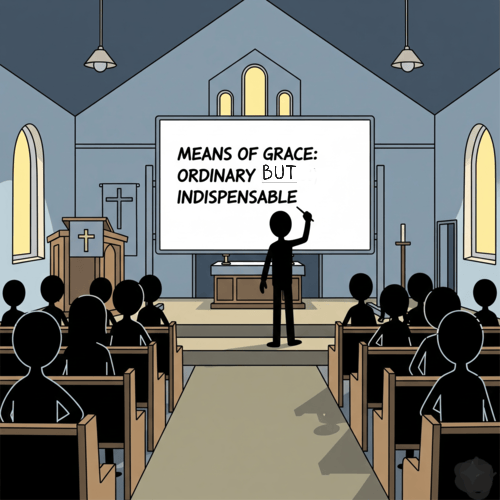The Comma Johanneum: Does It Undermine Bible Reliability?
When sceptics want to shake our confidence in Scripture, they often point to textual variants such as the Comma Johanneum. “If scholars can’t agree on whether this verse belongs in the Bible,” they ask, “how can you trust any of it?”
It’s a fair question that deserves a thoughtful answer. But here’s what might surprise some: the Comma Johanneum debate actually demonstrates the remarkable reliability of Bible transmission, not its weakness.
WHAT IS THE COMMA JOHANNEUM?
The Comma Johanneum refers to a portion of 1 John 5:7-8 that appears in the King James Version: “For there are three that bear record in heaven, the Father, the Word, and the Holy Ghost: and these three are one.”
This explicit Trinitarian statement is missing from virtually all early Greek manuscripts. It first appears in late medieval Latin texts and wasn’t added to Greek manuscripts until the 16th century. Modern translations like the ESV and NASB either omit it entirely or include it in brackets with explanatory notes.
The scholarly consensus is clear: the passage was likely a marginal note that later scribes incorporated into the main text.
WHY THIS ACTUALLY STRENGTHENS OUR CONFIDENCE
Before you panic about “missing” Bible verses, consider what the controversy reveals about Bible transmission.
First, we can identify textual variants precisely because we have such abundant manuscript evidence. With over 5,800 Greek New Testament manuscripts, we can trace the history of every significant variant. The Comma Johanneum stands out precisely because it’s absent from the overwhelming majority of early, reliable witnesses.
Second, this demonstrates the careful, providential process of textual preservation. God didn’t drop the Bible from heaven in leather binding. He worked through ordinary means—scribes, scholars, and centuries of careful copying—to preserve His Word. That some variants exist doesn’t undermine the process; it confirms that scholars take textual accuracy seriously.
Third, no essential Christian doctrine depends on any disputed passage. The Trinity is taught clearly throughout Scripture in passages such as Matthew 28:19, 2 Corinthians 13:14, and John 1:1-14. Removing the Comma Johanneum doesn’t touch these foundations.
THE REFORMED FRAMEWORK FOR TEXTUAL CRITICISM
Reformed theology provides a robust framework for handling textual variants without losing confidence in Scripture’s authority.
- God’s providence extends to textual criticism. The same divine sovereignty that inspired Scripture also governs its preservation and our understanding of it. When honest scholarship reveals textual issues, we’re not undermining God’s Word—we’re honoring His commitment to truth.
- Scripture interprets Scripture. One unclear or disputed passage never overthrows the clear teaching of multiple texts. The Reformed principle of letting Scripture’s plain passages illuminate its difficult ones applies to textual variants too.
- The Holy Spirit guides the church into truth. This includes guiding scholars and translators in their work. The convergence of textual evidence pointing away from the Comma Johanneum isn’t an attack on faith—it’s the Spirit working through ordinary means to clarify God’s Word.
ADDRESSING THE REAL CONCERNS
Let’s tackle other questions this raises.
“If scholars can question this verse, what else might be wrong?” The beauty of textual criticism is it reveals how stable the biblical text actually is. Over 99% of the New Testament text is certain, and no disputed variant affects core Christian doctrine. The Comma Johanneum is notable precisely because such significant variants are rare.
“Doesn’t this prove the Bible has been corrupted?” There’s a crucial difference between transmission variants and doctrinal corruption. Variants like the Comma Johanneum represent honest copying differences, not theological manipulation. The early church’s commitment to accurate transmission shows in their careful preservation of even difficult passages.
“How can we trust any translation?” Good translations handle disputed passages transparently. When the ESV brackets questionable text or adds footnotes about manuscript differences, it’s demonstrating integrity, not uncertainty. This openness should increase, not decrease, our confidence.
STRONGER FAITH THROUGH HONEST SCHOLARSHIP
The Comma Johanneum controversy illustrates a profound truth: Christianity isn’t threatened by honest investigation. Our faith is strong enough to acknowledge textual questions while maintaining confidence in Scripture’s essential message.
The gospel remains secure. Christ’s divinity, the Trinity’s reality, and salvation by grace alone don’t depend on any single disputed verse. They rest on the clear, converging testimony of Scripture as a whole.
Rather than undermining Bible reliability, the Comma Johanneum debate showcases it. We can trace textual variants, explain their origins, and make informed decisions about biblical text precisely because God has providentially preserved such abundant manuscript evidence.
This is what biblical reliability actually looks like—not the absence of all textual questions, but the presence of sufficient evidence to resolve them faithfully. The Comma Johanneum isn’t a crack in Scripture’s foundation. It’s a testament to the careful, providential process by which God has preserved His Word for us.
THE COMMA JOHANNEUM: RELATED FAQs
How does the Comma get its name? The term “Comma Johanneum” comes from Latin, where “comma” means a short clause or phrase, and “Johanneum” refers to the apostle John’s writing. It was coined by scholars to describe this specific textual insertion in 1 John 5:7-8. The name became standard in academic discussions during the 18th and 19th centuries when textual criticism was developing as a formal discipline.
- What do leading contemporary Reformed scholars say about the Comma Johanneum? Virtually all major Reformed scholars today—including Wayne Grudem, Michael Horton, RC Sproul, and John MacArthur—acknowledge the Comma Johanneum isn’t original to John’s letter. They consistently emphasise this conclusion doesn’t weaken Trinitarian doctrine since it’s firmly established elsewhere in Scripture. Reformed seminaries and institutions teach this scholarly consensus while maintaining full confidence in biblical authority.
- Did the early church fathers know about the Comma Johanneum? Early church fathers like Athanasius, John Chrysostom, and Jerome regularly quoted 1 John 5:7-8 when defending the Trinity, but they never cited the Trinitarian formula found in the Comma. This is particularly significant because they were actively combating Arian heresy and would have enthusiastically used such explicit Trinitarian language if it existed. Their silence speaks volumes about the passage’s later origin.
Why don’t some modern translations even mention the Comma in footnotes? Some translations like the NIV omit footnotes about the Comma because the manuscript evidence is so overwhelmingly against its authenticity that scholars consider the case closed. Others, like the ESV, include notes to help readers understand why older translations differ. Both approaches reflect editorial decisions about how much textual information to provide general readers rather than disagreement about the evidence itself.
- What role did the printing press play in spreading the Comma? The printing press inadvertently gave the Comma Johanneum a permanence that handwritten manuscripts never could. Once Erasmus included it in his widely-printed Greek text, it became the “received text” (Textus Receptus) that dominated Protestant translations for centuries. Before printing, scribes could easily skip questionable additions, but printed editions locked in textual decisions and spread them globally.
- Are there other significant textual variants Reformed Christians should know about? Yes, several other passages face similar questions, including the longer ending of Mark (16:9-20), the woman caught in adultery (John 7:53-8:11), and Acts 8:37. Reformed scholars handle these consistently—acknowledging textual questions while noting that no essential doctrine depends on disputed passages. This approach demonstrates that Christian faith can confidently engage with scholarly investigation.
What’s the difference between the Comma Johanneum and other translation differences? Most translation differences involve interpretation of authentic Greek text—should “logos” be “word” or “message”? The Comma Johanneum is different because it questions whether certain words were ever in the original text at all. This makes it a textual rather than translational issue. Both types of questions are normal parts of bringing ancient texts into modern languages.
THE COMMA JOHANNEUM: RELATED FAQs
- The Deuteronomy 34 Mystery: Who Wrote Moses’ Obituary?
- Can We Trust John’s Gospel? Answering Your Toughest Challenges
- How ‘Embarrassing Details’ Strengthen the Case for Gospel Authenticity
Editor's Pick

Should We Stop Using Male Pronouns for God? Why Do We Say No?
A friend of ours arrived eagerly at his first theology class in seminary. But he quickly discovered something troubling: the [...]

Did Old Testament Law Force Women to Marry their Rapists?
**Editor’s Note: This post is part of our series, ‘Satan’s Lies: Common Deceptions in the Church Today’… Viral misinformation abounds [...]

From Danvers To Nashville: Two Statements, One Biblical Vision
30 years separate the Danvers Statement on Biblical Manhood and Womanhood (1987) and the Nashville Statement on Human Sexuality (2017). [...]

The Nashville Statement: Why Affirm It Despite Media Backlash?
WHY DO REFORMED CHRISTIANS STAND BY THIS STATEMENT ON MARRIAGE AND GENDER? When the Nashville Statement was released in 2017, [...]

Who Is Belial? Solving The 2 Corinthians 6:15 Mystery
Belial: This name from the pages of Scripture chills the soul. Who is this mysterious figure Paul invokes in 2 [...]

Celibacy Or Castration: What Jesus Really Means in Matthew 19:12
One of Scripture's most shocking misinterpretations led theologian Origen to castrate himself in the third century. His tragic mistake? Taking [...]

Philippians 4:13: Did Paul Really Mean We Can Do ALL Things?
"I can do all things through Christ who strengthens me." It's on gym walls, graduation cards, and motivational posters everywhere. [...]

The Ordinary Means of Grace: Why Are They Indispensable?
ORDINARY MEANS FOR EXTRAORDINARY TRANSFORMATION What if God's most powerful work in believers' lives happens through the most ordinary activities? [...]

Is the Bible God’s Word? Or Does It Only Contain God’s Word?
The authority of Scripture stands at the crossroads of modern Christianity. While some argue the Bible merely contains God’s Word [...]

Will We Remember This Life in Heaven? What Isaiah 65:17 Means
"Will I remember my spouse in heaven? My children? Will the joy we shared on earth matter in eternity?" These [...]
SUPPORT US:
Feel the Holy Spirit's gentle nudge to partner with us?
Donate Online:
Account Name: TRUTHS TO DIE FOR FOUNDATION
Account Number: 10243565459
Bank IFSC: IDFB0043391
Bank Name: IDFC FIRST BANK






